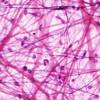Exam 1 Flashcards
(236 cards)
Plasma membrane
Surrounds the outside of the cell Composed of a lipid bilayer and proteins Polar heads on outside, non- polar/hydrophobic tails on inside
What types of proteins are associated with the lipid bilayer?
Peripheral and integral membrane proteins
What are the two faces of the plasma membrane? How do you image them?
E-face and P-face Image via freeze fracture technique - pull layers apart, proteins go with layers
Which face of the plasma membrane usually has more integral proteins associated with it?
The P face
E-face
The layer of the plasma membrane backed by the extracellular space
P-face
The layer of the plasma membrane backed by the cytoplasm (protoplasm)
What are the functions of different integral membrane proteins?
Pumps Channels Receptors Linkers Enzymes Structural
What are the different methods of transport across the plasma membrane?
Simple Diffusion Carrier Proteins Channel Proteins
Simple diffusion
Requires no proteins Particles are small and hydrophobic enough to cross the bilayer
Carrier proteins
May be passive (no energy required, usually high to low concentration gradient) or active (energy required, usually ATP) Highly selective
Channel proteins
Ion selective and based on cell needs Regulated by membrane proteins May be voltage-gated
Forms of vesicular transport
Endocytosis (pinocytosis, phagocytosis, receptor-mediated endocytosis) Exocytosis (constitutive, regulated)
Pinocytosis
“Cell drinking” Nonspecific Small proteins and fluid aka clathrin-independent endocytosis
Phagocytosis
Only occurs with specialized cells (i.e. macrophages, neutrophils) - Engulf cell debris and bacteria Requires the rearrangement of the actin cytoskeleton Forms phagosomes aka clathrin-independent, actin-dependent endocytosis
Receptor-mediated endocytosis
Vemicrotubulessicles form when receptors on the surface bind to specific cargo molecules Formation of endocytic vesicles may involve pitting of the membrane (clathrin helps form pit) - Cell membrane invaginates, forms a vesicle, and the vesicle travels along - uncoat vesicle when cargo inside is ready to be unloaded Formation of endocytic vesicles may be clathrin dependent or independent
Endosomes
Generally the end point of vesicular important May be early endosomes or late endosomes, although they eventually may become lysosomes As they mature, they become more acidic within the lumen
Early endosomes
Sort and recycle proteins pH 6.2-6.5 (slightly acidic, close to neutral)
Late endosomes
Pre-lysosomes pH around 5.5 (more acidic) Late endosomes fuse with lysosomes for degradation of lumenal content
Lysosomes
Degrade proteins/molecules from endocytic pathways and autophagy Very acidic - pH around 4.7 Digestive organelles with tough membranes that resist digestion - Contain a diverse array of acid hydrolases that become active when the lumen reaches a pH of 5 Lysosomal membrane proteins include lysosome-associted membrane proteins, glycoproteins, and other integral membrane proteins
What are the four pathways that lead to intracellular digestion in lysosomes?
Receptor-mediated endocytosis Pinocytosis Phagocytosis Autophagy
Proteasomes
Large nonmembranous cytoplasmic or nuclear protein complexes that are capable of degrading single polypeptides and proteins
Lysosomal Storage disorders
Deficiency in one or more lysosomal enzymes, leading to accumulation of substrate in the lysosome, which cause a cell to malfunction and eventually die Tay-Sachs disease I-cell disease Niemann-Pick disease (type A) Gaucher disease - Also includes the mucopolysaccharideoses, which result in deficiency in enzymes that degrade glycosaminoglycans, leading to accumulation of partially degraded glycosaminoglycans that, over time, leads to thickening of the tissue and compromised cell and organ function
Tay-Sachs disease
Lysosomal storage disorder characterized by: - loss of vision and hearing - muscle atrophy due to loss of nervous tissue - early death (often by age 5) - deficiency is in hexoaminidase - substrate that accumulates is GM2 ganglioside in neurons
I-cell disease
Lysosomal storage disorder characterized by: - skeletal abnormalities - hepatomegaly - mental retardation due to abnormal cellular architecture - early death (often by age 8) - deficiency is in N-acetylglucosaminyl-1-phosphotransferase - this leads to lysosomal hydrolases being secreted instead of being phosphorylated in the Golgi














































